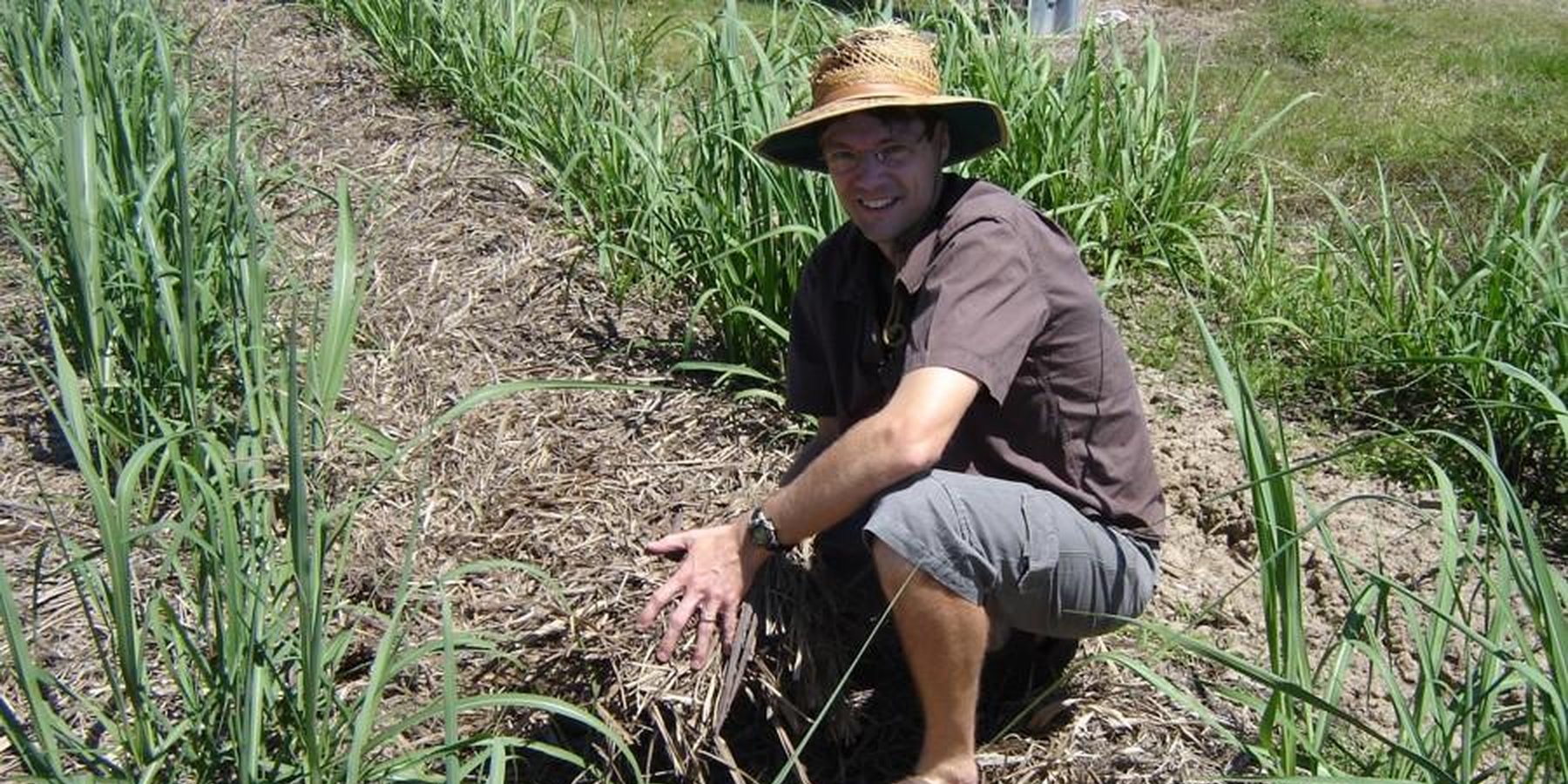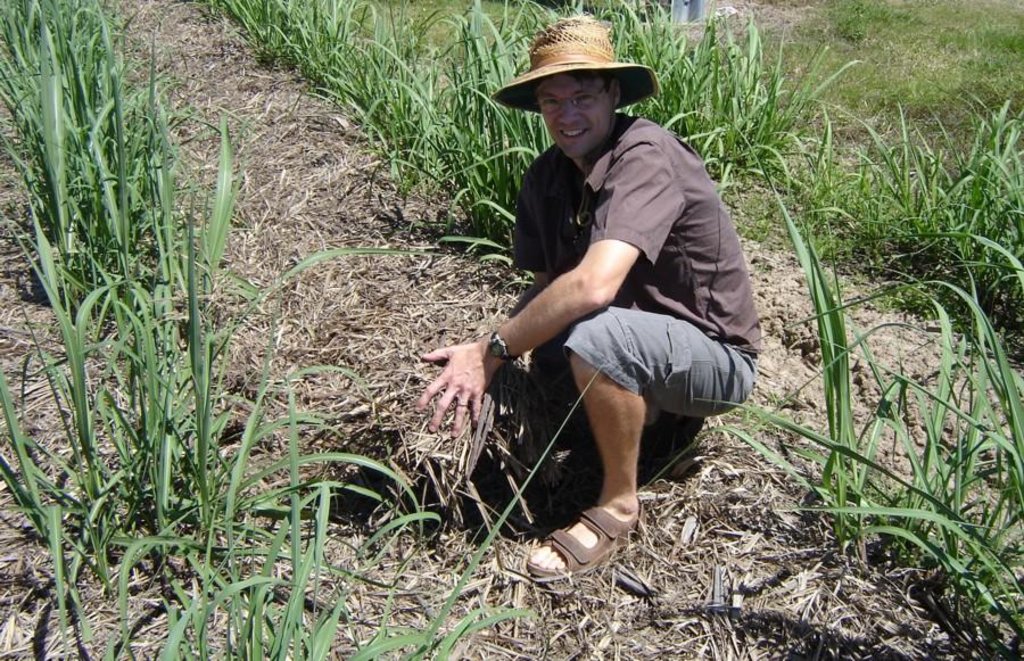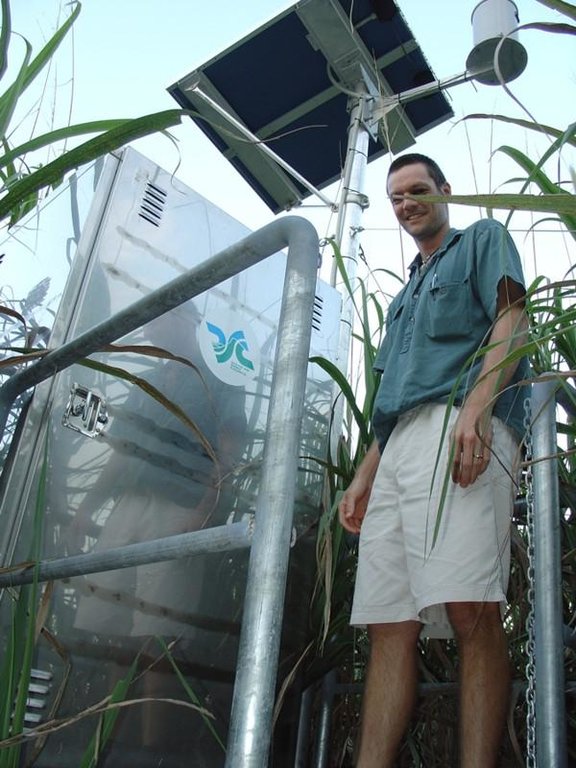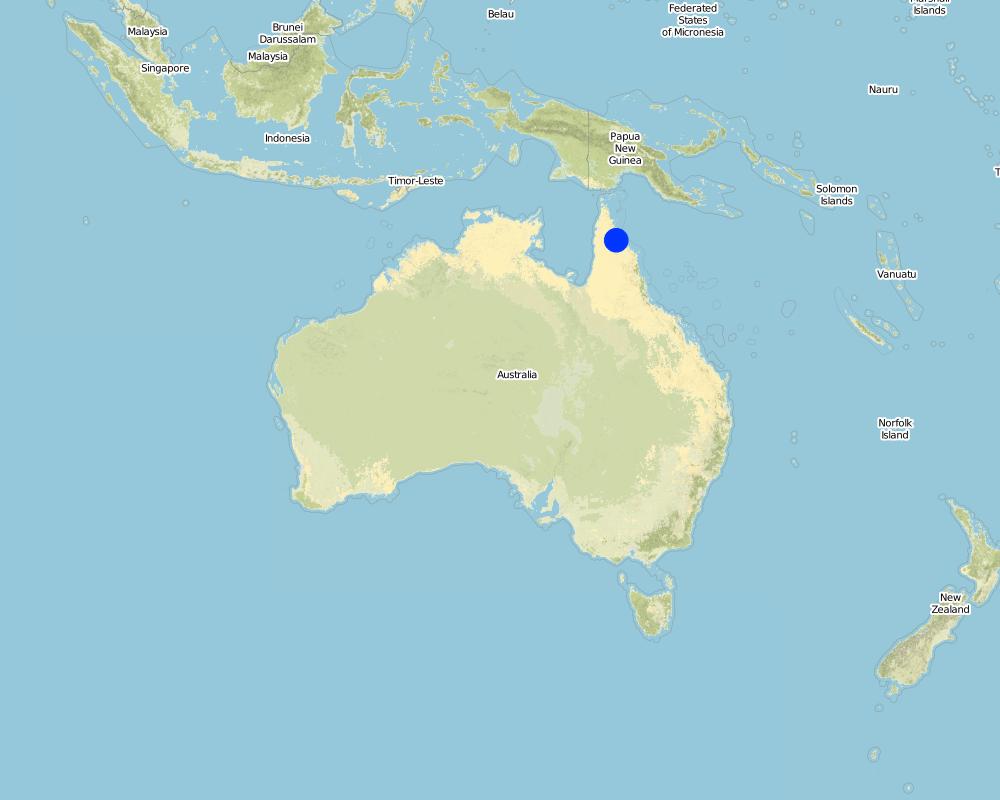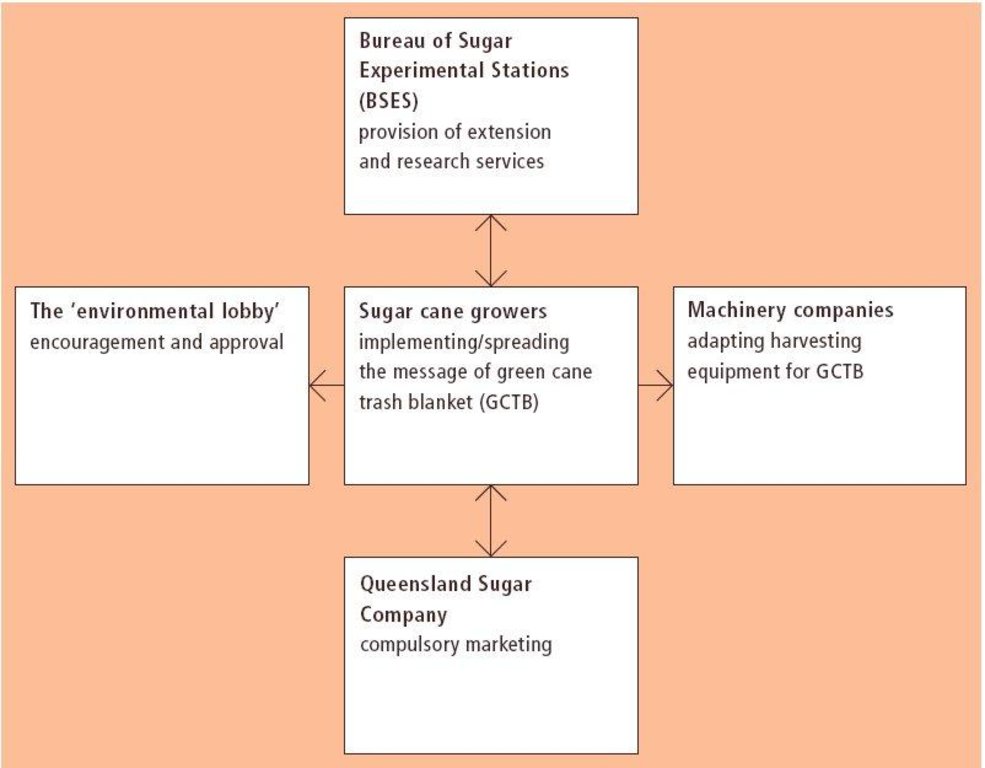The 'Triple bottom line' [澳大利亚]
- 创建:
- 更新:
- 编制者: Anthony J. Webster
- 编辑者: –
- 审查者: David Streiff, Deborah Niggli
approaches_2668 - 澳大利亚
查看章节
全部展开 全部收起1. 一般信息
1.2 参与方法评估和文件编制的资源人员和机构的联系方式
有助于对方法进行记录/评估的项目名称(如相关)
Book project: where the land is greener - Case Studies and Analysis of Soil and Water Conservation Initiatives Worldwide (where the land is greener)有助于对方法进行记录/评估的机构名称(如相关)
CSIRO (CSIRO) - 澳大利亚1.3 关于使用通过WOCAT记录的数据的条件
编制者和关键资源人员接受有关使用通过WOCAT记录数据的条件。:
是
1.4 SLM技术问卷的参考
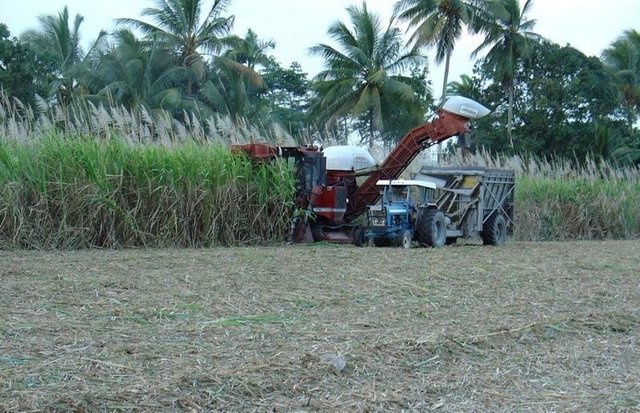
Green cane trash blanket [澳大利亚]
Elimination of burning as a pre-harvest treatment of sugar cane, and managing the resultant trash as a protective blanket to give multiple on and off-site benefits.
- 编制者: Anthony J. Webster
2. SLM方法的描述
2.1 该方法的简要说明
A new expression used by agriculturalists in Australia to explain why farmers change practices: the 'triple bottom line' implies economic, environmental and social concerns.
2.2 该方法的详细说明
该方法的详细说明:
Aims / objectives: A fundamental change has occurred in farming practice amongst sugar cane growers in the tropics of far north Queensland. Where it was once standard practice to burn cane before harvest (defoliating green canes for easier harvest), tradition has been turned on its head and now almost no-one burns. Instead a 'green cane trash blanket' system has developed, with multiple benefits and few or no drawbacks. There has been no official campaign or punitive sanctions imposed, no enticing financial incentives offered or charismatic environmental leadership - just a quiet technological revolution, based on the principles of the 'triple bottom line' (TBL).
Methods: TBL has recently emerged into common usage amongst agriculturalists in Australia. Rather than attributing farmers' actions as simple responses to economic stimuli ('the bottom line') TBL is a framework that helps explain the complexity of factors that influence farmers to modify their practices. TBL suggests that farmers do indeed respond to money, but also to environmental concerns, and furthermore to social considerations as well. This gives credit to farmers for being responsible stewards of the land. In this particular case, the transition in technology started in 1974, when sugar cane growers in the far north of Queensland were simply unable to burn their cane prior to harvest because of the exceptionally heavy rains. Instead, they had to harvest wet - and green. The technical implications were first, a slower harvest speed because machinery had to cope with a greater load of biomass, and second, a thick residual blanket of trash that covered the soil. The multiple benefits of mulching were recognised by a few growers, who then continued to harvest green cane. Non-burning spread - a technology now described as the 'green cane trash blanket'- until almost every grower adopted it within one generation. While the extension service has supported the transition, growers themselves tookthe initiative to change. There are indeed small financial benefits, chiefly in terms of reduced overall input costs, but growers have simultaneously been motivated by social and environmental considerations. Burning has come to be considered anti-social: a dirty practice, carrying the danger of fire spreading outside the targeted fields. Neither is it a pleasant task, requiring help of family and friends, often at inconvenient times.
Other important information: From an environmental perspective, the benefits of trash mulch are tangible in terms of improved soil quality, and reduced erosion rates. And, equally important, the end result is reduced damage to the close-by Great Barrier Reef with its sediment-sensitive living coral.
The triple bottom line(TBL) is an expression which has evolved in Australia to help explain why farmers act as they do. Its three components of economics, the environment and social aspects cover the considerations that cause farmers to modify technologies. TBL implicitly gives credit to farmer for being sensitive to multiple external signals. In this case the change in practice is from burning sugar cane to harvesting it green in Far North Queensland. This is a case where emerging conservation-friendly farmer practice and the goals of the environmental lobby have neatly coincided.
2.3 该方法的照片
2.5 采用该方法的国家/地区/地点
国家:
澳大利亚
区域/州/省:
Queensland
Map
×2.6 该方法的开始和终止日期
注明开始年份:
1974
2.7 方法的类型
- 传统/本土
2.8 该方法的主要目的/目标
The Approach focused on SLM only
(1) Demonstration and dissemination. (2) The spread of non-burning practices, specifically the 'green cane trash blanket' technology to promote sustainable and environmentally friendly sugar cane production. (3) Indirectly: to satisfy social concerns associated with burning of sugar cane.
The SLM Approach addressed the following problems: (1) Anti-social farming practice of burning sugar cane which also has negative environmental impacts, both in situ, and offsite in the coral reef. (2) Resistance to change in traditional farming practice.
2.9 推动或妨碍实施本办法所适用的技术的条件
社会/文化/宗教规范和价值观
- 阻碍
traditional way of doing things/social resistance
Treatment through the SLM Approach: demonstration and dissemination of benefits
财务资源和服务的可用性/可得性
- 阻碍
Higher costs of harvesting (a small premium charged by contractors per tonne of green cane harvested).
Treatment through the SLM Approach: These costs are offset by lower tillage input, no costs associated with burning, and lower inputs of agrochemicals also.
法律框架(土地使用权、土地和水使用权)
- 启动
- 阻碍
了解SLM,获得技术支持
- 阻碍
Harvesting machines at first were not so well able to cope with the greater biomass to be harvested.
Treatment through the SLM Approach: Manufacturers developed higher capacity harvesters.
3. 相关利益相关者的参与和角色
3.1 该方法涉及的利益相关者及其职责
- 当地土地使用者/当地社区
There is no difference between men and women in principle, though de facto most growers are male.
- 国家政府(规划者、决策者)
politicians (govt. agencies)
- environmentalists
3.2 当地土地使用者/当地社区参与该方法的不同阶段
| 当地土地使用者/当地社区的参与 | 指定参与人员并描述活动 | |
|---|---|---|
| 启动/动机 | 自我动员 | starting up the practice; starting up the practice of green cane trash blanket (GCTB) |
| 计划 | 无 | |
| 实施 | 互动 | spreading the word; growers spreading the word, support by extension services |
| 监测/评估 | 互动 | growers joining hands with research; formal and informal disseminations of observations |
| Research | 互动 | growers joining hands with research. Quantifying benefits short, long term and downstream |
3.3 流程图(如可用)
具体说明:
Institutional framework Inter-relationships between sugar cane growers and other stakeholders.
3.4 有关SLM技术选择的决策
具体说明谁有权决定选择要实施的技术:
- 仅限土地使用者(自主)
解释:
sugar cane growers
Decisions on the method of implementing the SLM Technology were made by by land users* alone (self-initiative / bottom-up)
4. 技术支持、能力建设和知识管理
4.1 能力建设/培训
是否为土地使用者/其他利益相关者提供培训?:
否
4.2 咨询服务
土地使用者有权使用咨询服务吗?:
是
指明是否提供了咨询服务:
- 在土地使用者的土地上
说明/注释:
Name of method used for advisory service: green cane trash blanket (GCTB) system; Key elements: visits, Field days, publications; (1) Advisory service was carried out through: Bureau of Sugar Experimental Stations (BSES).(2) Advisory service was carried out through: Bureau of Sugar Experimental Stations (BSES).
4.3 机构强化(组织发展)
是否通过这种方法建立或加强了机构?:
- 否
4.4 监测和评估
监测和评估是该方法的一部分吗?:
是
注释:
Technical aspects were ad hoc monitored by land users through observations
There were None changes in the Approach as a result of monitoring and evaluation: Not applicable.
4.5 研究
研究是该方法的一部分吗?
是
明确话题:
- 经济/市场营销
- 生态学
- 技术
提供进一步的细节,并指出是谁做的研究:
There has been some ad hoc research carried out on technical parameters by both the BSES as well as CSIRO.
5. 融资和外部物质支持
5.1 该方法中SLM组成部分的年度预算
注释(例如主要的资助来源/主要捐助者):
Approach costs were met by the following donors: government (national government, Bureau of Sugar Experiment Stations): 20.0%; other (growers themselves): 80.0%
5.2 为土地使用者提供财政/物质支援
土地使用者是否获得实施该技术的财政/物质支持?:
是
如果是,请具体说明支持的类型、条件和提供者:
By government (national government, Bureau of Sugar Experiment Stations)
5.3 对特定投入的补贴(包括劳动力)
- 无
如果土地使用者的劳动力是一项重要的投入,那么是不是:
- 自愿
注释:
Farmers themselves provide labour
There are no subsidies connected to GCTB. Australia does not subsidise its sugar cane growers and sugar is sold at the world price.
5.4 信用
是否根据SLM活动的方法给予信用值?:
否
6. 影响分析和结论性陈述
6.1 方法的影响
该方法是否帮助土地使用者实施和维护SLM技术?:
- 否
- 是,很少
- 是,中等
- 是,支持力度很大
Considerable: nutrient losses reduced, erosion reduced, organic matter built up, etc.
Did other land users / projects adopt the Approach?
- 否
- 是,很少
- 是,中等
- 是,支持力度很大
The 'triple bottom line' is probably active throughout Australia in influencing farmers??? decisions.
6.3 方法活动的可持续性
土地使用者能否维持通过该方法实施的措施(无外部支持的情况下)?:
- 是
若是,请说明如何维持:
By definition this is sustainable: it is an internal mechanism amongst farmers.
6.4 该方法的长处/优点
| 编制者或其他关键资源人员认为的长处/优势/机会 |
|---|
| Farmers take the responsibility of choosing a land management practice that has a positive 'triple bottom line': environmental, economic and social benefits. (How to sustain/ enhance this strength: Support awareness raising and give appreciation to the on-site and off-site benefits; acknowledge sugar produced under this system an environmentally friendly and economic product.) |
| Has successfully stimulated the spread of the green cane trash blanket system. (How to sustain/ enhance this strength: Outsiders should continue to support farmers' multiple concerns.) |
| Sugar cane growing has previously had a bad environmental and social reputation, especially here, close to the Great Barrier Reef, which is a World Heritage Site. This change in practice, resulting from the 'triple bottom line' has changed the reputation of sugar cane growers. (How to sustain/ enhance this strength: Make this public.) |
6.5 该方法的弱点/缺点以及克服它们的方法
| 编制者或其他关键资源人员认为的弱点/缺点/风险 | 如何克服它们? |
|---|---|
| The fact that farmers are responsive to environmental and social as well as economic stimuli is covered up by conventional thinking that 'only money matters to them'. | Investigation and documentation of the 'triple bottom line' is required. |
7. 参考和链接
7.1 方法/信息来源
- 实地考察、实地调查
- 与土地使用者的访谈
链接和模块
全部展开 全部收起链接

Green cane trash blanket [澳大利亚]
Elimination of burning as a pre-harvest treatment of sugar cane, and managing the resultant trash as a protective blanket to give multiple on and off-site benefits.
- 编制者: Anthony J. Webster
模块
无模块


